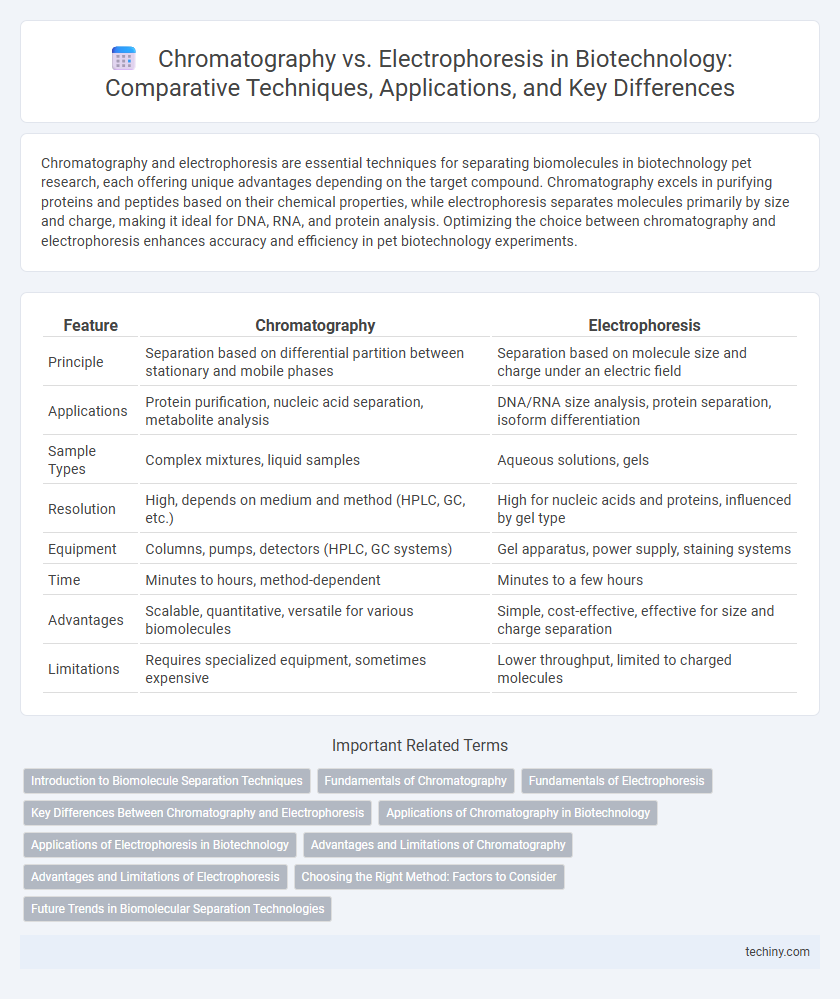Chromatography and electrophoresis are essential techniques for separating biomolecules in biotechnology pet research, each offering unique advantages depending on the target compound. Chromatography excels in purifying proteins and peptides based on their chemical properties, while electrophoresis separates molecules primarily by size and charge, making it ideal for DNA, RNA, and protein analysis. Optimizing the choice between chromatography and electrophoresis enhances accuracy and efficiency in pet biotechnology experiments.
Table of Comparison
| Feature | Chromatography | Electrophoresis |
|---|---|---|
| Principle | Separation based on differential partition between stationary and mobile phases | Separation based on molecule size and charge under an electric field |
| Applications | Protein purification, nucleic acid separation, metabolite analysis | DNA/RNA size analysis, protein separation, isoform differentiation |
| Sample Types | Complex mixtures, liquid samples | Aqueous solutions, gels |
| Resolution | High, depends on medium and method (HPLC, GC, etc.) | High for nucleic acids and proteins, influenced by gel type |
| Equipment | Columns, pumps, detectors (HPLC, GC systems) | Gel apparatus, power supply, staining systems |
| Time | Minutes to hours, method-dependent | Minutes to a few hours |
| Advantages | Scalable, quantitative, versatile for various biomolecules | Simple, cost-effective, effective for size and charge separation |
| Limitations | Requires specialized equipment, sometimes expensive | Lower throughput, limited to charged molecules |
Introduction to Biomolecule Separation Techniques
Chromatography and electrophoresis are fundamental biomolecule separation techniques used in biotechnology to isolate and analyze proteins, nucleic acids, and small molecules. Chromatography relies on differential partitioning between stationary and mobile phases to separate components based on properties like size, charge, or affinity. Electrophoresis separates charged biomolecules using an electric field, enabling size and charge-based resolution critical for molecular characterization and purity assessment.
Fundamentals of Chromatography
Chromatography separates biomolecules based on differential affinities between a mobile phase and a stationary phase, enabling precise isolation of proteins, nucleic acids, and small molecules. Key techniques include liquid chromatography, gas chromatography, and affinity chromatography, each tailored for specific molecular interactions and target compounds. This method offers high resolution and scalability, crucial for applications in pharmaceutical development and molecular biology research.
Fundamentals of Electrophoresis
Electrophoresis separates biomolecules based on their charge and size by applying an electric field through a gel matrix, enabling distinct migration rates for proteins or nucleic acids. The gel medium, typically agarose or polyacrylamide, acts as a molecular sieve, facilitating resolution of molecules according to shape and molecular weight. Electrophoresis is fundamental in analyzing genetic material, protein purity, and molecular interactions, making it indispensable in biotechnology research and diagnostics.
Key Differences Between Chromatography and Electrophoresis
Chromatography separates biomolecules based on their differential affinities to stationary and mobile phases, enabling purification of complex mixtures like proteins, nucleic acids, and small metabolites. Electrophoresis relies on the migration of charged particles through a gel matrix under an electric field, predominantly used for DNA, RNA, and protein size and charge analysis. Key differences include chromatography's separation by chemical properties versus electrophoresis' dependence on molecular charge and size, with chromatography suited for preparative scale separations and electrophoresis ideal for analytical resolution.
Applications of Chromatography in Biotechnology
Chromatography is extensively employed in biotechnology for purifying proteins, nucleic acids, and small biomolecules, enabling precise separation based on molecular size, charge, or affinity. Techniques like affinity chromatography facilitate the isolation of specific biomolecules, critical for drug development and vaccine production. High-performance liquid chromatography (HPLC) is pivotal for analyzing complex mixtures, quality control, and ensuring the consistency of biopharmaceutical products.
Applications of Electrophoresis in Biotechnology
Electrophoresis is widely applied in biotechnology for the separation and analysis of nucleic acids, proteins, and small molecules based on their size and charge. Techniques such as agarose gel electrophoresis and SDS-PAGE enable precise identification of DNA fragments and protein expression profiles, vital for genetic research and protein characterization. This method supports molecular cloning, sequencing, and diagnostic assays by facilitating rapid, high-resolution molecular separation essential for experimental accuracy and reproducibility.
Advantages and Limitations of Chromatography
Chromatography offers high resolution and the ability to separate complex mixtures based on molecular size, charge, or affinity, making it ideal for purifying biomolecules like proteins and nucleic acids. It provides scalability for both analytical and preparative purposes, but can be time-consuming and often requires expensive equipment and consumables. Limitations include potential sample loss during multiple steps and less effectiveness for separating molecules with very similar properties compared to electrophoresis.
Advantages and Limitations of Electrophoresis
Electrophoresis offers high-resolution separation of nucleic acids and proteins based on size and charge, enabling precise analysis of biomolecules in biotechnology research. Its advantages include simplicity, cost-effectiveness, and capacity for simultaneous processing of multiple samples, making it suitable for DNA fingerprinting and protein profiling. Limitations encompass lower scalability compared to chromatography, sensitivity to buffer conditions, and difficulty in separating very large or similarly charged molecules, which can restrict its application in complex mixture analysis.
Choosing the Right Method: Factors to Consider
Choosing between chromatography and electrophoresis depends on sample complexity, target molecule properties, and resolution requirements; chromatography excels in separating complex mixtures with high throughput, while electrophoresis offers precise separation of nucleic acids and proteins based on size and charge. Sample volume and purity levels influence method selection, as chromatography handles larger volumes with diverse sample types, whereas electrophoresis is ideal for analytical applications requiring detailed molecular profiling. Cost, equipment availability, and downstream application compatibility also play critical roles in determining the optimal separation technique in biotechnology workflows.
Future Trends in Biomolecular Separation Technologies
Innovations in biomolecular separation technologies are steering towards hybrid systems that combine chromatography's high selectivity with electrophoresis's resolution and speed. Advances in microfluidics and nanotechnology are enabling miniaturized platforms for simultaneous multi-parameter analysis, increasing throughput while reducing sample volumes. Emerging AI-driven process optimization enhances precision and reproducibility in these integrated separation techniques, promising transformative impacts on biotechnology research and diagnostics.
Chromatography vs Electrophoresis Infographic

 techiny.com
techiny.com